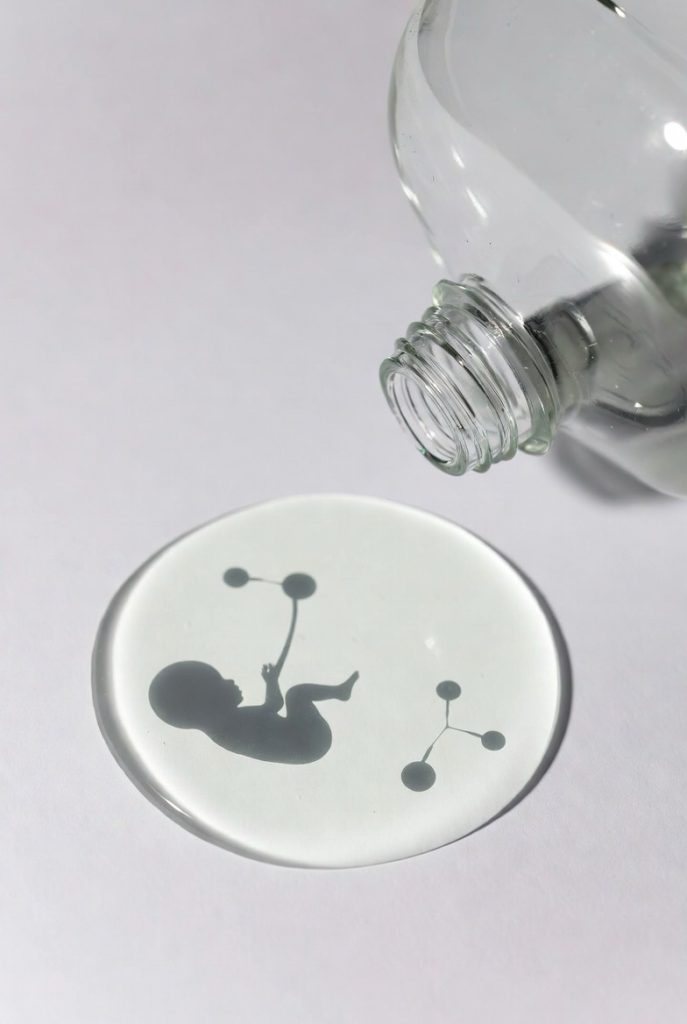Phthalates, plasticizers in cosmetics, food packaging, and personal care products, act as endocrine disruptors linked to health risks. Exposure occurs via ingestion, inhalation, and skin contact, with higher levels in pregnant women and children. Key biomarkers—urinary metabolites like MEHP, MEHHP, MEOHP, MBP, MEP, and MiBP—are measured using HPLC/MS/MS to assess daily intake and chronic exposure. These compounds cause oxidative stress (elevated ROS, TBARS, 8OHdG), reproductive issues (infertility, reduced semen quality, shorter AGD, preterm birth), and inflammation (CRP, IL-6 changes). Prenatal exposure affects placental health and fetal development. Risk assessment uses creatinine-adjusted urinary levels; most fall below safety thresholds, but mixtures raise concern. Reducing contact with phthalate-containing products lowers biomarker levels and health risks.
Long Version
Understanding Phthalate Health Biomarkers: Exposure, Effects, and Implications
Phthalates, a group of synthetic chemicals widely used as plasticizers in everyday products, have raised significant concerns due to their potential as endocrine disruptors and their impact on human health. These compounds are found in personal care products, cosmetics, food products, and various plastics, leading to widespread environmental exposure. Biomonitoring studies reveal that phthalate metabolites serve as key biomarkers for assessing exposure levels, with urinary concentrations and serum concentrations providing insights into daily intake and chronic exposure. This article delves into the intricacies of phthalate health biomarkers, exploring their identification, associated health effects, and the broader implications for risk assessment.
Sources and Pathways of Exposure
Humans encounter phthalates through multiple routes, including ingestion from contaminated food products, inhalation of indoor air, and dermal absorption from cosmetics and personal care products. As plasticizers, phthalates like DEHP (di(2-ethylhexyl) phthalate), DBP (di(n-butyl) phthalate), DEP (diethyl phthalate), BBzP (butylbenzyl phthalate), DOP (dioctyl phthalate), DiNP (diisononyl phthalate), and DiBP (diiso-butyl phthalate) leach from items such as food packaging, medical devices, and household plastics. Prenatal exposure occurs when these compounds cross the placental barrier, while chronic exposure accumulates over time, often detected in adipose tissue. Studies highlight higher exposure in vulnerable groups, such as pregnant women and children, where daily intake can exceed safe thresholds due to frequent contact with these sources. Recent insights emphasize the role of dietary sources in elevating phthalate levels, particularly through processed foods and packaging materials that contribute to ongoing accumulation.
Biomarkers and Metabolites: Tracking Exposure
Phthalate metabolites are the primary biomarkers used in biomonitoring to quantify exposure and toxicity. Upon ingestion or absorption, phthalates undergo hydrolysis and oxidation, producing metabolites like MEHP (mono(2-ethylhexyl) phthalate), MEHHP (mono(2-ethyl-5-hydroxyhexyl) phthalate), MEOHP (mono(2-ethyl-5-oxohexyl) phthalate), and MECPP (mono(2-ethyl-5-carboxypentyl) phthalate) from DEHP; MBP (monobutyl phthalate) and MiBP (monoisobutyl phthalate) from DBP and DiBP; MEP (monoethyl phthalate) from DEP; MBzP (monobenzyl phthalate) from BBzP; MCPP (mono-3-carboxypropyl phthalate) from DBP or BBzP; MMP (monomethyl phthalate) from dimethyl phthalate; MiNP (monoiso-nonyl phthalate) from DiNP; and MiDP (monoisodecyl phthalate) from diisodecyl phthalate. These metabolites are excreted primarily in urine, making urinary concentrations a reliable indicator, often higher than serum concentrations due to lower contamination risks.
Oxidative metabolites, such as MEHHP and MEOHP, are particularly valuable as they have longer half-lives and better reflect sustained exposure compared to hydrolytic ones like MEHP. Detection frequency varies, with most metabolites identifiable in over 90% of samples, and limits of detection (LOD) achieved through advanced analytical methods ensure accurate quantification. Emerging research has also explored how these biomarkers interact with other nutrients, such as folate, which appears to correlate with reduced concentrations of certain phthalate metabolites in urine, suggesting potential protective mechanisms.
Measurement Techniques in Biomonitoring
Biomonitoring relies on sophisticated techniques like HPLC/MS/MS (high-performance liquid chromatography-tandem mass spectrometry) and LC-MS/MS (liquid chromatography-mass spectrometry) for detecting phthalate metabolites in urine, serum, and cord blood. These methods involve enzymatic deconjugation, solid-phase extraction, and isotope-dilution for precision, with LODs in the low ng/mL range. For instance, in pregnant women, urinary concentrations are adjusted for creatinine to account for dilution, enabling comparisons across populations. Serum analysis requires precautions against contamination from esterases, often mitigated by additives like phosphoric acid. Advances in these techniques have improved sensitivity, allowing for the detection of even trace levels in diverse biological matrices.
Health Effects on Reproductive Health and Infertility
Phthalates are notorious reproductive toxicants, exerting antiandrogenic, antiestrogenic, and anti-thyroid effects that disrupt hormonal balance. Exposure is linked to infertility, with metabolites like MEOHP showing elevated risks. In males, this manifests as reduced semen quality, sperm DNA damage, hypospadias, cryptorchidism, and shortened anogenital distance (AGD). Females experience ovarian toxicity, longer time to pregnancy, and higher pregnancy loss rates. Prenatal exposure correlates with developmental toxicants affecting gestational age and birth weight, potentially leading to preterm birth. Recent meta-analyses have further connected phthalate exposure to early puberty, particularly in girls, where specific metabolites accelerate pubertal onset, highlighting the need for targeted interventions during critical developmental windows.
Oxidative Stress and the Antioxidant System
Phthalate exposure induces oxidative stress, marked by increased lipid peroxidation, reactive oxygen species (ROS), and reactive nitrogen species (RNS). Biomarkers in adipose tissue include elevated thiobarbituric acid reactive substances (TBARS), malondialdehyde, and 8-hydroxy-deoxyguanosine (8OHdG), indicating DNA and lipid damage. The antioxidant system responds with changes in glutathione peroxidase (GPx), glutathione reductase (GRd), total glutathione (GST), reduced glutathione (GSH), oxidized glutathione (GSSG), and the GSSG/GSH ratio. Low molecular weight phthalates like MMP and MiBP positively associate with GPx and TBARS, while high molecular weight ones like MiNP show inverse links. Hemeoxygenase-1 (HO-1) and superoxide dismutase (SOD) levels also fluctuate, highlighting phthalates’ role in disrupting redox homeostasis. Preventive strategies, such as antioxidant supplementation, have shown promise in mitigating these effects, particularly on reproductive and thyroid health, by bolstering the body’s defense against oxidative damage.
Inflammation and Related Biomarkers
Associations exist between phthalate biomarkers and inflammation markers like C-reactive protein (CRP) and interleukin-6 (IL-6). Metabolites such as MCNP show positive links with CRP, though attenuated by BMI adjustments. Inverse associations for MEP and MBzP with CRP suggest complex interactions, potentially mediated by obesity. Overall, phthalates may not strongly promote inflammation in all populations, but these findings underscore the need for further exploration in risk assessment. Expanded research indicates that chronic inflammation from phthalate exposure could contribute to broader systemic issues, including metabolic disturbances.
Metabolic and Cardiovascular Impacts
Beyond reproductive and oxidative effects, phthalates influence metabolic health, with exposure linked to increased insulin resistance, decreased insulin sensitivity, and higher risks of metabolic disorders. Biomarkers reveal alterations in glucose metabolism and lipid profiles, particularly in populations with high dietary intake from contaminated food sources. Additionally, emerging evidence ties phthalate metabolites to cardiovascular risks, including hypertension, through mechanisms involving oxidative stress and endothelial dysfunction. These connections emphasize phthalates’ role in long-term cardiometabolic health, with higher urinary concentrations correlating with elevated blood pressure and vascular changes.
Prenatal and Chronic Exposure: Long-Term Impacts
Prenatal exposure, assessed via maternal urinary concentrations, affects placental microvasculature, stiffness, and calcification, with metabolites like MEHP linked to adverse placental changes. Chronic exposure accumulates in adipose tissue, contributing to ongoing oxidative stress and inflammation. In infants, gestational phthalate levels associate with biomarkers of aging, such as altered mitochondrial DNA copy number (mtDNAcn) and relative leukocyte telomere length (rLTL), though evidence remains mixed. For example, monobutyl phthalate positively correlates with mtDNAcn, while mono-iso-butyl phthalate shows negative associations. Newer studies on newborn metabolomes reveal how prenatal phthalates disrupt metabolic pathways, potentially influencing neurobehavioral development and long-term health trajectories.
Risk Assessment and Estimating Daily Intake
Risk assessment involves calculating daily intake from urinary metabolites using formulas incorporating creatinine clearance and molar conversion factors. For DEHP, medians range from lower to higher values depending on the metabolite, typically below established minimal risk levels. Weighted quantile sum regression (WQS) evaluates mixture effects, revealing negative impacts on GSH and GSSG. Confidence intervals and adjusted odds ratios guide interpretations, emphasizing that while most exposures fall within safe limits, vulnerable groups face higher risks from cumulative effects. Regulatory standards continue to evolve, with calls for stricter limits on phthalates in consumer products to reduce overall exposure. Environmental health literacy, including behaviors that minimize phthalate contact, has been associated with lower biomarker levels, supporting public health initiatives.
In summary, phthalate health biomarkers provide critical insights into exposure and its multifaceted impacts on human health, from reproductive disruptions and oxidative stress to metabolic and cardiovascular risks. By integrating biomonitoring data with rigorous risk assessment and preventive measures, we can better mitigate these pervasive environmental threats and promote healthier outcomes across populations.







